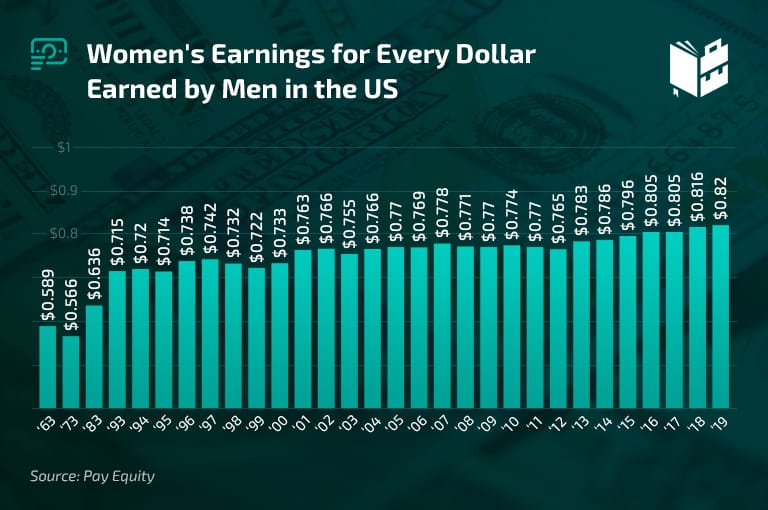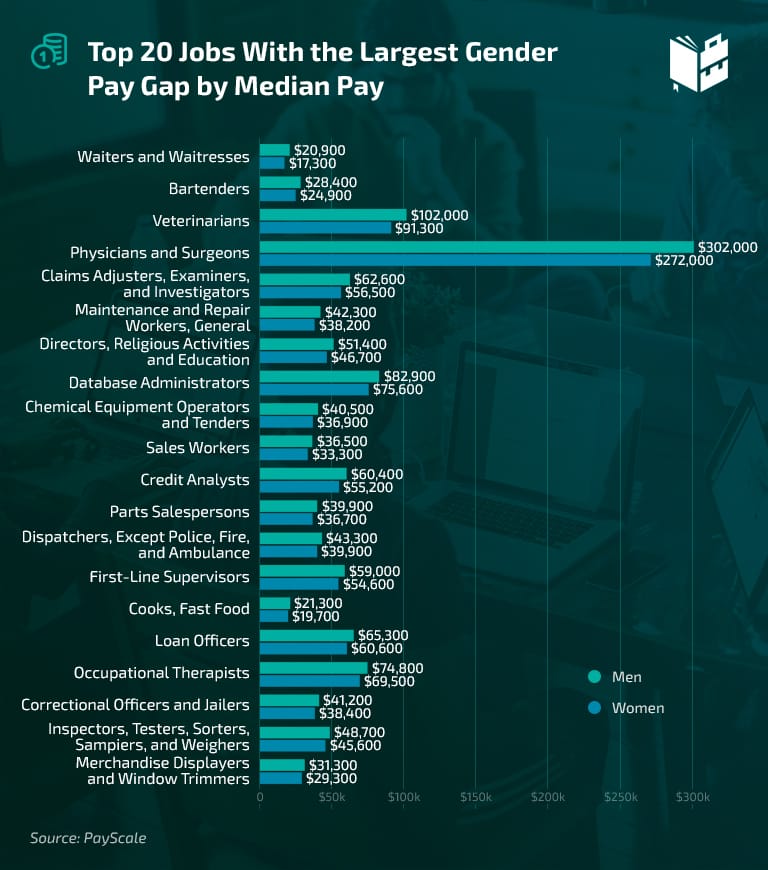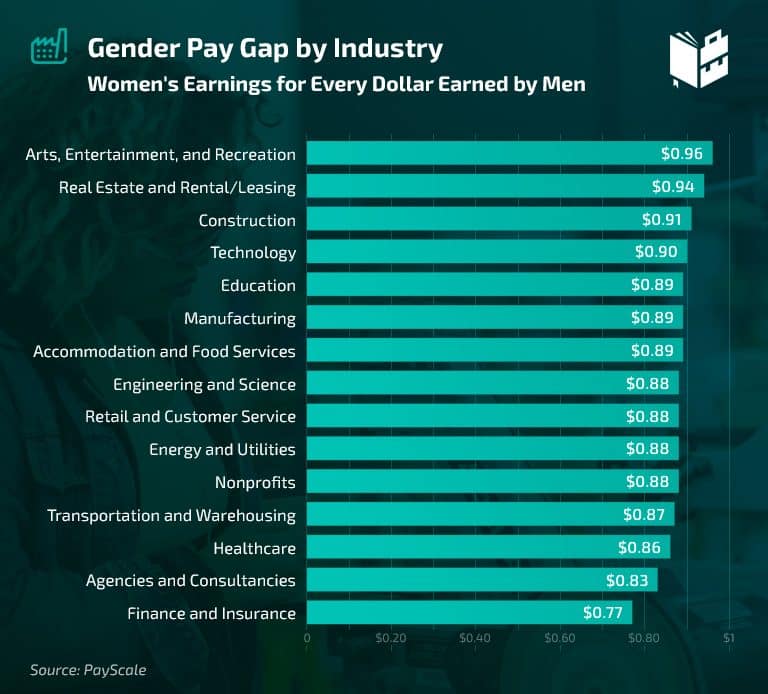Wage gap statistics show some improvements compared to previous years, yet figures on women in the workplace indicate severe racial and gender discrimination. Even though more and more women have essential business roles, there is still much to do to achieve financial equality.
The discrepancy between men’s and women’s salaries is vast, revealing that female workers have lower pay than male workers, even when they have the same qualifications and job roles. The stats below illustrate the wage gap, shedding light on the issue.
Wage Gap Facts and Stats (Editor’s Choice)
- Women make $0.82 to every dollar men make when the gender pay gap is uncontrolled
- During the pandemic, women have lost 5.4 million jobs
- Lesbian women earn 12% less than heterosexual women
- Women in executive positions earn $0.94 to every $1 their male colleagues earn
- The wage gap has been closing by half a cent per year since the Equal Pay Act of 1963
- According to 46% of men, the gender pay gap is a myth
- Black women in the controlled pay gap group make $0.97 to every $1 men make
- Throughout a 40-year career, women stand to lose $850,000 due to the gender pay gap
Gender Pay Gap Statistics
1. Women make $0.82 to every dollar men make when the gender pay gap is uncontrolled.
(PayScale)
The uncontrolled pay gap measures the median salary that men and women earn regardless of their job role or seniority. Recent data on the uncontrolled pay gap reveals that female workers earn $0.82 for every dollar male workers make. This is one cent more than they made in 2020. The slight improvement might be driven by the increased number of women who left the workforce due to family care or layoffs during the COVID-19 pandemic.
2. Women in the controlled group make $0.98 for $1 men earn.
(PayScale)
The controlled gender pay gap measures equal pay for equal work. Gender pay gap facts from reputable sources point out that women still make two cents less than men without any legitimate reason despite doing the same job and having the same skills. This gender pay gap has been closing slowly but steadily at 1% annually. Since 2015, it has decreased by $0.01.
3. Women who were laid off due to COVID-19 earned $0.79 for every dollar that men earned.
(PayScale)
Gender wage gap statistics show that the uncontrolled pay gap is wider for women who were laid off due to the COVID-19 crisis. They earned $0.79 compared to $1 that men made. The controlled pay gap is less significant—women who were laid off earned $0.98 for every $1 that men made.
4. The wage gap has been closing by half a cent per year since the Equal Pay Act of 1963.
(Pay Equity)
Since the Equal Pay Act, statistics on the wage gap have shown an incredibly slow improvement year after year. For example, in 1963, women made $0.59 for every $1 earned by men. In 2010, female workers earned $0.77, and now, they earn $0.82 for every $1 men earn. That means that in the past 40 years, the median earnings of female workers have been $700,000 to $2 million less than the earnings of male workers.

5. Gender pay gap statistics show that women make $850,000 less than men throughout their 40-year careers.
(PayScale)
Supposing that the wage gap remained the same and that employees got a standard 3% pay raise every year, women’s average earnings over 40 years would amount to $3,830,000. However, if women’s earnings were the same as men’s, the sum would increase substantially, amounting to $4,600,000.
These gender wage gap facts and figures suggest that the average income by gender differs significantly. The entire sum of money earned throughout women’s careers is $850,000 less than men’s. When the pay gap is controlled, women make $80,000 less than men for doing the same job. That means that women have to work more than one year longer to earn the same as men.
6. Men’s median salary is around 18% bigger than women’s median salary.
(PayScale)
Gender wage gap data reveals that women’s median pay is $50,700 when the pay gap is uncontrolled and $61,000 when the pay gap is controlled. Compared to men, the average difference in earnings for women in the uncontrolled group is $11,400 and $1,100 in the controlled group.

7. Women have lost 5.4 million jobs during the COVID-19 pandemic.
(Center for American Progress)
The latest pay gap statistics reveal that women have lost 5.4 million jobs during the pandemic—about 1 million more than men. In addition, approximately 2.4 million women have dropped out of the labor force during the pandemic to respond to child care demands due to school closures. In turn, only 1.8 million men have done the same.
8. According to 46% of men, the gender pay gap is a myth.
(Time)
Overall, 62% of Americans believe men earn more than women for doing the same job. However, nearly half of men see the men and women pay difference as a made-up notion “to serve a political purpose” and don’t consider it a legitimate issue. Additionally, 24% of men aged 18–34 say that media reports about unequal pay are fake news. Furthermore, out of surveyed men, only 48% characterized unequal pay as “very unfair,” while 58% said that the factors that made it harder for women to get ahead in the past no longer exist.
9. Women in executive positions make $0.94 to every $1 men make.
(PayScale)
According to recent gender wage gap stats, women in executive positions make $0.94 for every $1 men make. Compared to 2020, this is only a $0.01 improvement. Female executives earn $0.70 to men’s $1 within the uncontrolled pay gap group, an improvement of $0.01 from 2020. These numbers indicate that the wage gap widens as women progress and men’s wages increase significantly faster.
Discouraging Racial Wage Gap Statistics
10. American Indians and Alaska Natives earn $0.69 to every dollar white men earn.
(PayScale)
All men outrank women in the workforce within their ethnic group, even men of color who generally earn less than white men. American Indians and Alaska Natives experience the most significant uncontrolled pay gap. Women in this group earn $0.69, whereas men make $0.85 for every dollar white men earn. The gap has worsened by $0.06 for women since 2020.
11. Black women in the controlled pay gap group make $0.97 to every $1 white men make.
(PayScale)
Unequal pay is one of the most frequent and reported types of discrimination in the workplace. The pay gap rate is significant for black women in the controlled pay gap group. Black women’s median pay is $73,000 compared to $75,000 that white men make for the same job. That means that the pay disparity is $2,000 a year, which can amount to millions of dollars throughout black women’s careers.
12. Latinas are paid $0.55 for every $1 white, non-Hispanic men make.
(National Partnership for Women & Families)
Despite the importance of diversity in the workplace, women as members of minority groups are still discriminated against and earn significantly less than white, non-Hispanic men. The median pay for Latinas in the US is $36,110 compared to white men’s median salary of $65,208. That’s a difference of $29,098 a year, as gender pay gap data indicates.
13. Asian American and Pacific Islander women are paid $0.52 for every dollar white men make.
(National Partnership for Women & Families)
Asian American and Pacific Islander women experience a shocking gender pay gap. A typical Asian American woman earns a median annual salary of $56,807. That’s $8,401 less on a yearly basis than white, non-Hispanic men’s median salary, which is $65,208.
LGBT Facts About the Wage Gap You Shouldn’t Neglect
14. Lesbian women make 12% less money than heterosexual women.
(NBCNews)
Regardless of the company or position, lesbian women make less money than their heterosexual colleagues, even though there’s a general notion that lesbian women make more money than heterosexual women. On average, they make $45,606 a year, while straight women make $51,461 a year. The wage gap is even more significant between gay and straight men—$56,936 and 83,469, respectively.
15. On average, gay men make 11% less than straight men.
(Daily Beast)
Unfortunately, gay men don’t fare any better than lesbian women. As wage gap stats uncover, they make around 11% less than their straight counterparts, even after controlling for occupation, experience, skills, marital status, and location.
16. The average household income for same-sex couples amounts to $107,200.
(The US Census Bureau)
According to the latest research, same-sex married couples account for 1% of all households in the US. The median married couples income of same-sex families is $107,200, which is higher than heterosexual households that make $96,930. The median income of same-sex female married couples is $95,720, significantly less than same-sex male couples that earn $123,600.
17. The poverty rate for transgender people is 29.4%.
(Williams Institute)
According to the LGBT wage gap statistics, the poverty rate is different for same-sex marriages and different-sex marriages (6.6% and 5.6%, respectively). If we observe groups, 21.6% of LBGT people and 15.7% of cisgender people live in poverty. However, the biggest poverty rate can be seen in the transgender population—more transgender people live in poverty than lesbian, gay, or bisexual people. Transgender men have the highest poverty rate (33.7%), followed by transgender women (29.6%).
Eye-Opening Gender Pay Gap Stats by Industry
18. Finance and insurance have the biggest uncontrolled pay gap of 77 cents for $1.
(PayScale)
The wage gap statistics show that differences in pay are more obvious in specific industries. Undoubtedly, the biggest uncontrolled wage gap is seen in finance and insurance ($0.77). Agencies and consultancies come next at $0.83, followed by healthcare at $0.86. Transportation and warehousing have a pay gap of $0.87, while retail and customer service, nonprofits, energy and utilities, and engineering and science each see a gap of $0.88. The slightest uncontrolled pay gap is found in the arts, entertainment, and recreation industries ($0.96). Similarly, real estate and rental have a pay gap of $0.94.

19. Male athletes make from 15% to almost 100% more than female athletes.
(Adelphi University)
The pay rate varies from sport to sport, but generally, women are paid significantly less than men. The gender pay gap in sports statistics show that the average player compensation for a male athlete in basketball is $8.3 million, whereas women earn $75,181. When it comes to softball/baseball, the gap is even wider—men make on average $4 million compared to women who make only $6,000. The gap exists in golf ($1.2 million vs. $48,993), soccer ($410,730 vs. $35,000), and tennis ($335,946 vs. $283,635).
20. Women holding education, library, and training positions make 71 cents for every dollar men make.
(PayScale)
Even though 74% of educators, trainers, and librarians are women, the wage gap percentage is vast. To illustrate, they make only $0.71 to $1 their male counterparts make. Although women account for 70% of the overall education workforce, they mainly teach in elementary schools. Men, on the other hand, have the privilege to teach in high schools.
21. Female employees in the healthcare sector make 96 cents for every dollar that male employees make.
(PayScale)
Although women dominate the healthcare sector, women’s pay gap facts indicate they earn less. Even though men account for only 15% of healthcare workers, they still earn more than their female colleagues. The statistics on the average income by gender show that women in healthcare earn $0.96 for every $1 earned by men.
22. The controlled pay gap between university and high school degrees is $0.98.
(PayScale)
Having a higher education doesn’t mean women are paid the same as men. Recent wage gap data reveals that the controlled pay gap between higher education and high school degrees is $0.98. Furthermore, the controlled wage gap for MBAs and health professional doctorates is $0.96, whereas bachelor’s degrees see a pay gap of $0.99. On the other hand, women with MBAs in the uncontrolled pay gap group make $0.76 for every $1 that men with the same degree make.
23. Female legal and social service professionals make $1 for each $1 that men make when data is controlled.
(PayScale)
As per statistics on the wage gap, there’s a closing of the controlled pay gap for legal service professions. Women employed in these two sectors make one dollar for one dollar that men earn. On the other hand, maintenance, installation, and repair positions witness the widest controlled wage gap—$0.94. The wage gap in construction and extraction is $0.96, while food preparation and serving, management, and protection services have a pay gap of $0.97.
24. The wage gap exists even in industries where both men and women have the same qualifications and do the same job.
More pay gap facts indicate that the issue is more significant in male-dominated industries, but that is not always the case. The following list involves 10 occupations where men make more money for the same job:
- Sales representatives and related occupations – $0.90
- Emergency management specialist – $0.89
- Police officers – $0.89
- Gaming supervisors – $0.88
- Drivers – $0.86
- Waiters and waitresses – $0.86
- Fashion designers – $0.85
- Computer operators – $0.85
- Farm and other agricultural managers – $0.84
- Anesthesiologists – $0.83
25. Female producers and directors make 6% more than their male counterparts.
(Business.org)
Surprisingly, facts about the gender pay gap reveal that some occupations favor women. Female producers and directors make 6% more than their male counterparts.
Additionally, women in office and administrative support roles make 5% more than men. Female bus drivers, wholesale and retail buyers, and fast food and counter workers make 2% more than men who do the same jobs. Such a slight advantage in favor of either gender is reasonable, considering that the pay gap among sales agents and real estate brokers is vast—women make only 69% of the amount men make.
The Bottom Line: Effects of Gender Pay Gap
The wage gap doesn’t only affect finances, but it also has an adverse effect on workers’ mental health and physical well-being. Even though the level of discrimination and wage gap is significantly reduced compared to previous decades, it’s still present across various industries.
Employees who face pay, gender, and racial discrimination often feel exhausted and frustrated. These physical and mental states may even result in depression or anxiety disorders. Considering that women are expected to work and take care of their families at the same time, it’s not surprising that their mental health is in danger.